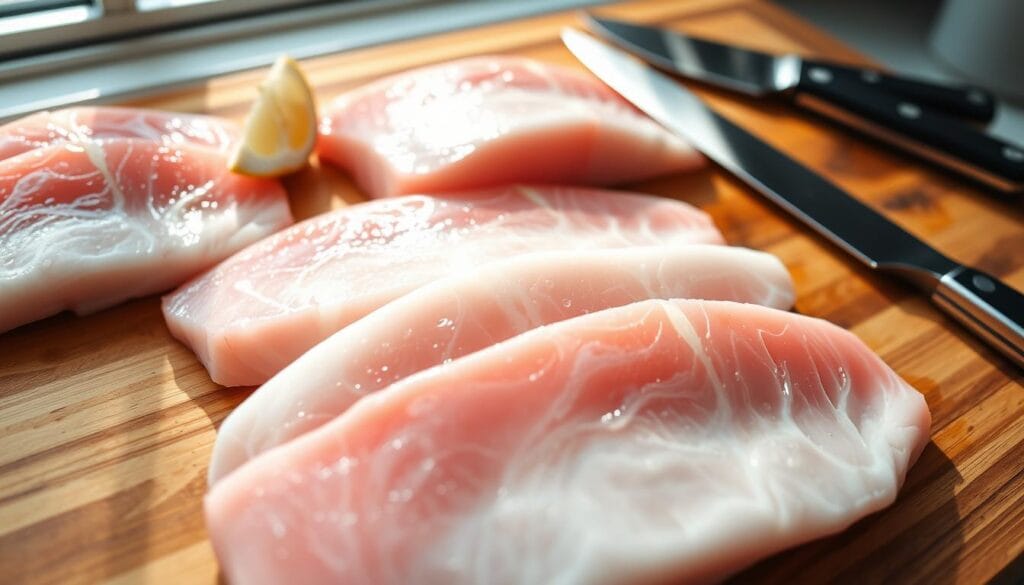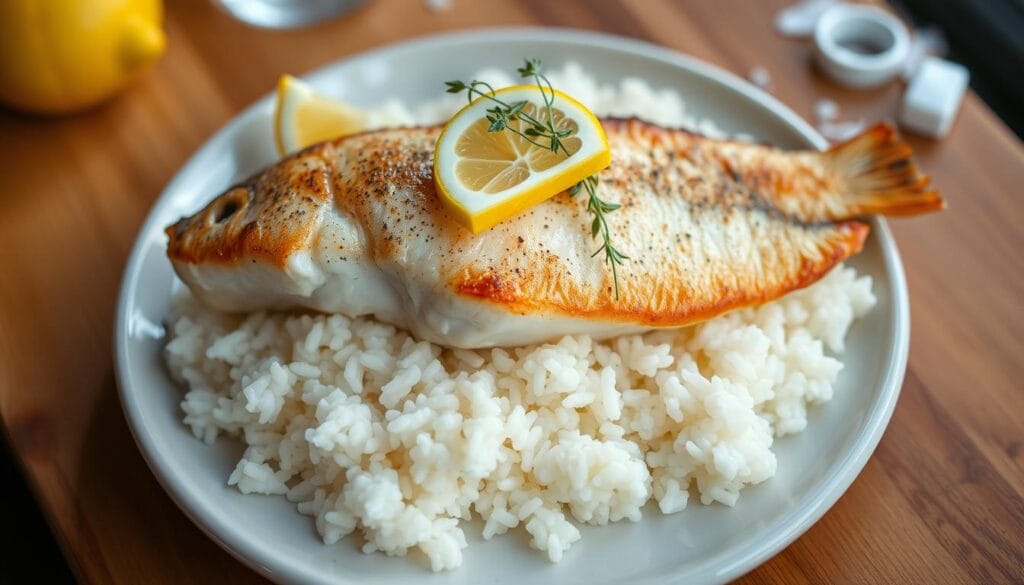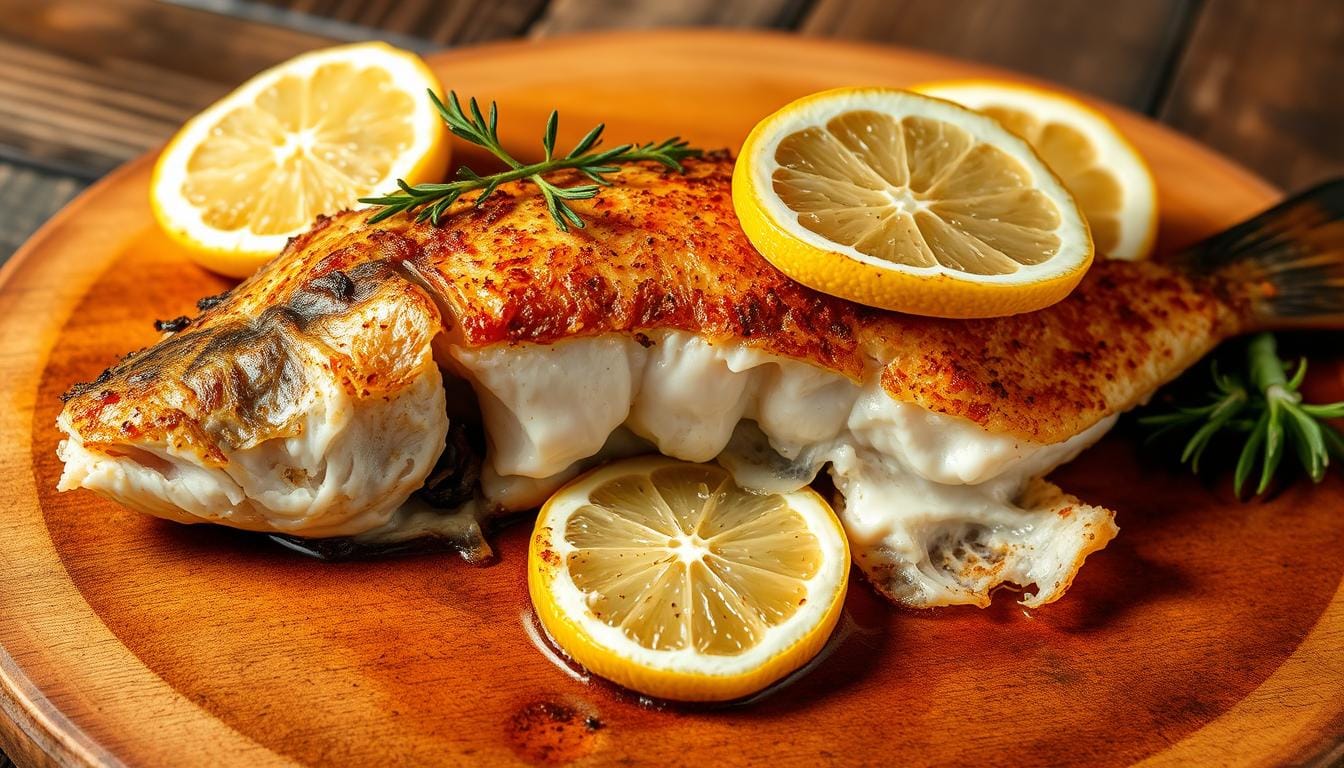Ever wanted a seafood dish that’s easy to make and full of flavor? I have a secret that changed my cooking: the perfect baked mahi recipe. Growing up by the Pacific, I learned mahi-mahi is more than a fish. It’s a culinary adventure.
Table of Contents
This easy baked mahi recipe will make you a seafood master. Mahi-mahi’s firm texture and mild sweetness make it perfect for cooking. It’s great for family meals or impressing guests, making your cooking better.
Ready to see how easy and tasty a baked mahi recipe can be? From picking the freshest fish to learning simple cooking tricks, you’ll make restaurant-quality seafood at home.
Key Takeaways
- Mahi-mahi offers a mild, sweet flavor perfect for baking
- The recipe is simple enough for beginner cooks
- Healthy and delicious seafood option
- Versatile dish that can be seasoned multiple ways
- Quick preparation and cooking time
What Makes Mahi-Mahi the Perfect Fish for Baking
Finding the right fish for your baked mahi recipe can change your cooking game. Mahi-mahi is a top pick for those wanting a tasty and healthy meal.
Understanding Mahi-Mahi’s Texture and Taste
Mahi-mahi brings a special taste to your table with its mild, sweet flavor. Its firm, white flesh is perfect for baking. It’s like cod but with a unique taste that soaks up flavors well.
- Mild, non-fishy taste
- Firm white flesh
- Versatile cooking properties
Health Benefits of Mahi-Mahi
Your baked mahi mahi recipe is not just tasty—it’s also full of good stuff. It’s a great source of lean protein and has lots of nutrients with little fat.
- High in protein
- Low in calories
- Rich in omega-3 fatty acids
- Supports heart and muscle health
Selecting Fresh vs. Frozen Mahi-Mahi
Choosing the right fish for your recipe is key. Fresh mahi-mahi has a pinkish-white color with red or dark spots. It should smell clean and feel firm.
Pro tip: Frozen mahi-mahi is just as good and often easier to find. Just thaw it right and handle it carefully before cooking.
Essential Ingredients for Perfect Baked Mahi Recipe
To make a tasty baked mahi mahi fish recipe, start with the right ingredients. Choose fresh, high-quality items that bring out the best in this seafood.
- Fresh mahi-mahi fillets
- Fresh lemon
- Unsalted butter
- Garlic
- Italian seasoning
- Sea salt
- Freshly ground black pepper
Choosing top-notch mahi-mahi fillets is key for a great dish. Look for fillets that are:
- Firm to the touch
- Vibrant and clear in appearance
- Mild in scent
“The quality of your ingredients directly impacts the final taste of your baked mahi-mahi.” – Culinary Experts
Adding herbs and spices can make your baked mahi mahi even better. Try:
- Smoked paprika
- Fresh thyme
- Dill
- Tarragon
| Ingredient | Flavor Profile | Purpose |
|---|---|---|
| Lemon | Bright, citrusy | Adds freshness and cuts through richness |
| Butter | Rich, creamy | Provides moisture and depth |
| Garlic | Pungent, savory | Enhances overall flavor complexity |
Pro tip: Always pat your mahi-mahi fillets dry before cooking. This helps get a perfect golden crust and better flavor.
Kitchen Tools and Equipment Needed
To make a simple baked mahi recipe, you need the right tools. The right equipment makes cooking easy and fun. It lets you focus on making a delicious meal.
Before starting your simple baked mahi recipe, get these essential tools:
- Baking sheet with high-quality non-stick surface
- Parchment paper or aluminum foil
- Instant-read meat thermometer
- Mixing bowls in various sizes
- Measuring cups and spoons
- Sharp kitchen knife
- Cutting board
- Basting brush
Baking Sheet Preparation Tips
Your baking sheet is key for even cooking. Line the sheet with parchment paper or aluminum foil to prevent sticking. A light-colored sheet helps avoid overcooking your fish.
Temperature Monitoring Tools
An instant-read meat thermometer is essential. It ensures your fish is cooked just right. Choose a digital thermometer with a thin probe for accurate readings.
Additional Kitchen Essentials
Having extra tools can improve your cooking. A pair of kitchen tongs, a zester for citrus, and a reliable oven mitt make cooking safer and more enjoyable.
Preparing Your Mahi-Mahi for Baking

Starting a great baked mahi recipe means getting the fish ready right. The success of your mahi-mahi depends on how you handle it. You want to bring out its natural taste and keep it tender.
Before you start your easy baked mahi recipe, do these important steps:
- Remove fish from refrigerator 15-20 minutes before cooking
- Pat fillets completely dry with paper towels
- Check for any remaining bones
- Trim irregular edges for even cooking
Drying your mahi-mahi is key for a golden-brown outside. Too much moisture stops seasonings from sticking and can make it steam instead of bake. Use clean paper towels to gently blot each fillet, removing surface moisture without damaging the delicate flesh.
| Preparation Step | Purpose | Technique |
|---|---|---|
| Room Temperature | Even Cooking | Rest for 15-20 minutes before baking |
| Pat Dry | Seasoning Adherence | Use paper towels to remove moisture |
| Trim | Uniform Cooking | Cut irregular edges for consistent thickness |
For the best results with your baked mahi recipe, handle the fish gently. Mahi-mahi is a delicate fish that needs careful preparation. This helps keep its flavor and texture just right.
Simple Marinade and Seasoning Techniques
Creating a tasty baked mahi recipe begins with a good marinade and seasoning. The secret to a great healthy baked mahi recipe is knowing how to boost the fish’s flavor without drowning it.
Marinades can turn your mahi-mahi into something truly special. The right mix of ingredients can make the fish taste amazing while keeping it juicy and full of flavor.
Lemon-Butter Marinade Essentials
A classic lemon-butter marinade is perfect for mahi-mahi. Here’s a simple recipe to make your fish taste amazing:
- 1/4 cup olive oil
- 2 tablespoons fresh lemon juice
- 2 minced garlic cloves
- 1 tablespoon butter
- Salt and black pepper to taste
Herb and Spice Combinations
Try these flavorful herb and spice mixes for your delicious baked mahi recipe:
- Mediterranean blend: Dill, oregano, and lemon zest
- Cajun-style: Paprika, cayenne, and thyme
- Tropical twist: Cilantro, lime, and cumin
The key to a healthy baked mahi recipe is finding the right balance. Use herbs and spices to enhance, not overwhelm, the fish’s natural taste. Start with a light hand and adjust as needed.
Step-by-Step Baking Instructions

Preparing a simple baked mahi mahi fillet recipe needs precision and care. Your journey starts with careful preparation and attention to detail. The right technique turns this delicate fish into a restaurant-quality meal in your kitchen.
Follow these essential steps for your baked mahi mahi fillet recipe:
- Preheat your oven to 400°F, ensuring an optimal cooking environment
- Pat the mahi-mahi fillets dry with paper towels to remove excess moisture
- Place the fillets on a lightly greased baking sheet
- Season generously with your prepared marinade or spice blend
- Bake for approximately 10 minutes until fish becomes opaque
The secret to a perfect simple baked mahi recipe is in the cooking time. Overcooking makes the fish dry and tough. Look for visual cues like the fish turning from translucent to white and flaking easily with a fork.
For a golden, crispy exterior, switch your oven to broil for the final 1-2 minutes. This adds a delightful texture to your mahi-mahi, making it look like a restaurant dish at home.
Pro tip: Always remove the fish from the oven when it’s slightly underdone, as it will continue cooking from residual heat. Garnish with fresh parsley or lemon wedges for a burst of freshness.
Perfect Temperature and Timing Guide
Getting the perfect baked mahi mahi recipe needs careful attention to temperature and timing. Knowing when your fish is done can turn a great meal into a disaster.
Signs of Perfectly Cooked Fish
When you’re making an easy baked mahi recipe, look for these signs:
- Flesh turns from translucent to opaque white
- Fish flakes easily with a fork
- Internal temperature reaches 145°F
- Meat appears moist and tender
Avoiding Common Baking Mistakes
To make sure your baked mahi mahi is perfect, avoid these mistakes:
- Overcooking: Mahi mahi cooks fast and can get dry quickly
- Using too high temperatures
- Not using an instant-read thermometer
- Not drying the fish before baking
Experts say to bake mahi mahi at 400°F for 10-12 minutes, depending on the thickness. Always check the internal temperature for the best results.
Pro Tip: Remove fish from the oven when it’s just barely cooked through to maintain moisture and prevent toughening.
Delicious Side Dish Pairings
Creating a great baked mahi recipe is more than just the fish. The right sides can make your dish amazing. Choose sides that complement the flavors and make a complete meal.
Here are some great side dish ideas for mahi-mahi:
- Tropical Rice Pilaf – A light, fluffy rice with tropical flavors that match the fish’s taste
- Roasted Mediterranean Vegetables – Colorful and nutritious, adding vibrant colors to your plate
- Citrus Berry Salad – A refreshing salad that brightens up the dish
- Garlic Parmesan Baked Potato – A creamy, indulgent side that pairs well with the fish
- Grilled Asparagus with Lemon Zest – A simple yet elegant vegetable side
The goal is to balance flavors. Your sides should enhance the mahi-mahi’s taste without overpowering it. Choose light, fresh sides to let the fish’s flavor shine.
Pro tip: Think about how you’re cooking the mahi when picking sides. Lighter dishes go well with crisp salads. More robust flavors need heartier veggies.
Storage and Reheating Tips
Keeping your baked mahi recipe fresh is key. After you’ve enjoyed your meal, you’ll want to keep the leftovers tasty. This way, you can enjoy them again later.
Refrigeration Guidelines
Put your leftover mahi-mahi in an airtight container. This helps keep it fresh. Make sure to refrigerate it quickly and keep it at a steady temperature. Your mahi can stay good in the fridge for up to three days.
Best Reheating Methods
- Oven reheating: Preheat to 275°F
- Air fryer: Use medium-low setting
- Avoid microwave to prevent drying out
When reheating your mahi, be gentle. The oven or air fryer is best. They help keep the fish moist and tender.
Creative Leftover Ideas
Turn your leftover mahi into new dishes. Here are some tasty ideas:
- Mahi-mahi fish tacos
- Flaked fish over mixed green salad
- Mahi-mahi fish cakes
| Storage Method | Duration | Recommended Technique |
|---|---|---|
| Refrigerator Storage | Up to 3 days | Airtight container |
| Reheating Temperature | 275°F (Oven) | Gentle, even heating |
Pro tip: Always ensure your leftover baked mahi is heated to an internal temperature of 145°F for food safety.
Conclusion
Your journey with this delicious baked mahi recipe has opened a new world of seafood cooking. This recipe is more than just a meal. It’s a way to enjoy fresh, healthy, and tasty meals at home.
Mahi-mahi is a great canvas for your cooking creativity. You can choose from simple lemon-butter marinades to bold herb mixes. This recipe shows how easy it is to make a dish that wows everyone.
Choosing sustainable seafood is important. When you make your baked mahi mahi, pick options from responsible fisheries. This choice helps the ocean and makes your seafood better.
We encourage you to make this recipe your own. Try new seasonings and side dishes. Cooking is an adventure, and this mahi-mahi recipe is a great start for seafood lovers.
FAQ
How long does it take to bake mahi-mahi?
Baking mahi-mahi takes 10-15 minutes, depending on the fillet’s thickness. Bake at 400°F (204°C) until it’s opaque and flakes with a fork. For 1-inch thick fillets, 12-13 minutes is best.
What are the best seasonings for baked mahi-mahi?
Use light, bright seasonings for mahi-mahi. Try lemon zest, fresh dill, garlic powder, paprika, and sea salt. A lemon-butter marinade also works well, enhancing the fish’s flavor.
Is mahi-mahi a healthy fish to eat?
Yes, it’s very healthy! Mahi-mahi is low in calories and high in nutrients. It has omega-3 fatty acids, vitamin B12, and selenium. A 3-ounce serving has 20 grams of protein and 130 calories.
Can I use frozen mahi-mahi for this recipe?
Yes, frozen mahi-mahi works too. Thaw it in the fridge and pat dry to remove moisture. Adjust cooking times if needed, and use a thermometer to check for doneness.
What should I serve with baked mahi-mahi?
Serve mahi-mahi with light, fresh sides. Try citrus berry salad, roasted asparagus, quinoa pilaf, or a light rice blend. Grilled veggies or a Mediterranean salad also pair well.
How do I know when mahi-mahi is fully cooked?
It’s done at 145°F (63°C). It should be opaque and flake easily. The flesh should be white or golden and moist.
How should I store leftover baked mahi-mahi?
Store it in an airtight container in the fridge for 2 days. Wrap it tightly in foil or plastic wrap. Reheat at 275°F (135°C) to keep it moist.
Can I use other types of fish for this recipe?
This recipe works for mild, firm white fish like halibut, cod, or sea bass. Just adjust cooking times based on the fish’s thickness.


